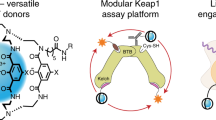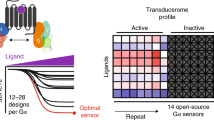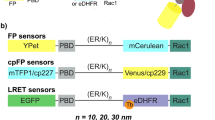Abstract
Bioluminescence resonance energy transfer (BRET) is a well-established method for investigating protein-protein interactions. Here we present a BRET approach to monitor ligand binding to G protein–coupled receptors (GPCRs) on the surface of living cells made possible by the use of fluorescent ligands in combination with a bioluminescent protein (NanoLuc) that can be readily expressed on the N terminus of GPCRs.
This is a preview of subscription content, access via your institution
Access options
Subscribe to this journal
Receive 12 print issues and online access
$259.00 per year
only $21.58 per issue
Buy this article
- Purchase on Springer Link
- Instant access to full article PDF
Prices may be subject to local taxes which are calculated during checkout


Similar content being viewed by others
References
Pfleger, K.D.G. & Eidne, K.A. Nat. Methods 3, 165–174 (2006).
Jaeger, W.C., Armstrong, S.P., Hill, S.J. & Pfleger, K.D. Front. Endocrinol. (Lausanne) 5, 26 (2014).
Pfleger, K.D., Seeber, R.M. & Eidne, K.A. Nat. Protoc. 1, 337–345 (2006).
Kocan, M., See, H.B., Seeber, R.M., Eidne, K.A. & Pfleger, K.D. J. Biomol. Screen. 13, 888–898 (2008).
Griss, R. et al. Nat. Chem. Biol. 10, 598–603 (2014).
Vernall, A.J., Hill, S.J. & Kellam, B. Br. J. Pharmacol. 171, 1073–1084 (2014).
Hall, M.P. et al. ACS Chem. Biol. 7, 1848–1857 (2012).
Baker, J.G. Br. J. Pharmacol. 144, 317–322 (2005).
Baker, J.G. et al. Br. J. Pharmacol. 159, 772–786 (2010).
May, L.T., Bridge, L.J., Stoddart, L.A., Briddon, S.J. & Hill, S.J. FASEB J. 25, 3465–3476 (2011).
Stoddart, L.A. et al. Chem. Biol. 19, 1105–1115 (2012).
Vernall, A.J. et al. Org. Biomol. Chem. 11, 5673–5682 (2013).
Vernall, A.J., Stoddart, L.A., Briddon, S.J., Hill, S.J. & Kellam, B. J. Med. Chem. 55, 1771–1782 (2012).
Baker, J.G. & Hill, S.J. J. Pharmacol. Exp. Ther. 320, 218–228 (2007).
Middleton, R.J. et al. J. Med. Chem. 50, 782–793 (2007).
Calebiro, D. et al. Proc. Natl. Acad. Sci. USA 110, 743–748 (2013).
Zwier, J.M. et al. J. Biomol. Screen. 15, 1248–1259 (2010).
Cottet, M. et al. Biochem. Soc. Trans. 41, 148–153 (2013).
Fernández-Dueñas, V. et al. J. Neurochem. 123, 373–384 (2012).
Dacres, H., Michie, M., Wang, J., Pfleger, K.D. & Trowell, S.C. Biochem. Biophys. Res. Commun. 425, 625–629 (2012).
Acknowledgements
The authors thank C. Corona and P. Meinsenheimer (Promega) for providing the alprenolol-TAMRA fluorescent ligand and J. Denman (The University of Nottingham) for assistance with generating the NanoLuc-adenosine receptor constructs. This project was funded by the Australian Research Council (ARC) Linkage Grant LP130100037. The University of Nottingham, Promega Corporation and BMG Labtech Pty Ltd provided funding as partner organizations of this grant. E.K.M.J. was funded by the Richard Walter Gibbon Medical Research Scholarship from The University of Western Australia. Work in S.J.H.'s laboratory was funded by the UK Medical Research Council (G0800006). K.D.G.P. was funded by an ARC Future Fellowship (FT100100271) and subsequently a National Health and Medical Research Council of Australia RD Wright Fellowship (1085842). S.J.H. thanks the Raine Foundation for a Visiting Research Professorship to The University of Western Australia.
Author information
Authors and Affiliations
Contributions
L.A.S., E.K.M.J., A.J.W., J.G., M.B.R. and T.M. performed the research. L.A.S., E.K.M.J., M.B.R., K.V.W., S.J.H. and K.D.G.P. designed the research study. L.A.S., E.K.M.J., A.J.W., J.G. and M.B.R. analyzed the data. L.A.S., S.J.H. and K.D.G.P. wrote the paper.
Corresponding authors
Ethics declarations
Competing interests
M.B.R., T.M. and K.V.W. are employees of Promega Corporation, which has proprietary rights over the NanoBRET assay. S.J.H. is a former Director of the University of Nottingham spin-out company CellAura Technologies, which provided some of the fluorescent ligands.
Integrated supplementary information
Supplementary Figure 1 Comparison of Rluc8-β2AR and Nluc-β2AR luminescence spectra
We generated luminescence spectra with HEK293 cells transiently transfected with Rluc8-β2AR or Nluc-β2AR following addition of coelenterazine h or furimazine substrate respectively. (a) Presentation as normalized luminescence illustrates that the Nluc emission peak is left-shifted by about 20 nm compared to Rluc8, thus enabling better spectral separation from the acceptor emission. (b) Presentation of the same spectra in terms of measured luminescence in relative light units (RLU) without normalization to the peak emission. This illustrates the substantially greater luminescence, and therefore energy transfer potential, of Nluc compared to Rluc8 despite the spectrum being left-shifted (Nluc peak (462 nm): 113,909 RLU; Rluc8 peak (480 nm): 1642 RLU). This becomes more relevant as more red-shifted energy acceptors are utilized, and therefore the spectral overlap of the donor emission spectrum with the acceptor excitation spectrum diminishes. The high luminescence output of Nluc means that this reduced overlap is much less of an issue compared with Rluc8. The data shown here are representative of three independent experiments.
Supplementary Figure 2 Microscopy images comparing the cellular localization of Rluc8-β2AR and Nluc-β2AR
(a) Images of HEK293 cells transiently transfected with Rluc8-β2AR indicate that this fusion protein is not appropriately trafficked to the plasma membrane. (b) This is in contrast to Nluc-β2AR that is clearly localized at the plasma membrane. We acquired images of eight different fields of view per sample and two representative fields are shown. Furthermore, the data are representative of three independent experiments. Nluc is derived from the luciferase expressed in deep sea shrimp Oplophorus gracilirostris. The native luciferase is secreted by the shrimp in bright luminescent bursts to ward off predators1. It has therefore evolved to be secreted and therefore pass through cellular membranes. This is not the case for Renilla luciferase. Indeed multiple attempts have been made to generate a secreted Renilla luciferase2. However, addition of the signal peptide of human interleukin-2 resulted in a secreted form of Rluc with 15 times less activity than cytosolic Rluc in mammalian cells3. The reason for this was unclear, but one suggested possibility was that addition of the signal peptide resulted in misfolding in the endoplasmic reticulum.
1. Hall, M.P. et al. ACS Chem. Biol. 7, 1848–1857 (2012).
2. Tannous, B.A. & Teng, J. Biotechnol. Adv. 29, 997–1003 (2011).
3. Liu, J, O'Kane D.J., Escher, A. Gene 203, 141–148 (1997).
Supplementary Figure 3 BRET binding assessed with propranolol-BY630 and propranolol-BYFL
(a,b) We treated HEK293 cells stably expressing Nluc-β2AR with 10 nM propranolol-BY630 (a) or 10 nM propranolol-BYFL (b) and increasing concentrations of unlabeled ligands as shown. In the presence of 10 µM propranolol we observed a decrease of 69.2 ± 1.3% in propranolol-BY630 BRET signal, whereas with propranolol-BYFL we only achieved a 25.6 ± 1.2% decrease in signal. Each data point represents mean ± s.e.m. of five (all curves in (a) and propranolol in (b)) or four (b) separate experiments. In each experiment we made triplicate determinations for each data point.
Supplementary Figure 4 Kinetic measurements of binding of CA200645 to Nluc-A1 receptor
We treated HEK293 cells stably expressing Nluc-A1 receptor with various concentrations of CA200645. We measured BRET between Nluc and the fluorescent ligand every min for 60 min at room temperature. The data shown are representative of three independent experiments performed in triplicate. From global fitting of the data, the kinetic parameters for CA200645 at Nluc-A1 receptor are kon = 9.64 ± 0.32 x 105 M−1 min−1 and koff = 0.019 ± 0.005 min−1 with a resulting KD of 20.4 ± 6.9 nM (mean ± s.e.m., n=3).
Supplementary Figure 5 Inhibition of BRET between NanoLuc and CA200645 at the adenosine A1 and A3 receptors by four additional compounds
(a,b) We treated HEK293 cells stably expressing Nluc-A1 receptor (a) or Nluc-A3 receptor (b) with 25 nM CA200645 and increasing concentrations of unlabeled ligands as shown. We monitored the resulting concentration dependent decrease in BRET and each data point represents mean ± s.e.m. of five (a: propranolol, ZM241385), four (a: XAC, PSB 603; b: PSB 603) or three (b: propranolol, ZM241385, XAC) experiments performed in triplicate.
Supplementary Figure 6 Inhibition of BRET between NanoLuc and AV039 at the adenosine A3 receptor by a panel of eight GPCR antagonists
(a,b) We treated HEK293 cells stably expressing Nluc-A3 receptor with 10 nM AV039 and increasing concentrations of unlabeled ligands as shown. The resulting concentration dependent decrease in BRET was monitored and each data point represents mean ± s.e.m. of four experiments performed in triplicate.
Supplementary Figure 7 Saturation and competition ligand binding with ABEA-X-BY630 at Nluc-A1 and Nluc-A3 receptors
(a) We treated HEK293 cells stably expressing Nluc-A1 receptor with increasing concentrations of ABEA-X-BY630. We established non-specific binding in the presence of 1 µM DPCPX and measured the resulting BRET ratios after 1 h incubation at 37 °C. (b–d) We also performed competition BRET binding assays on Nluc-A1 (b, c) and Nluc-A3 (d) receptor-expressing HEK293 cells treated with 250 nM ABEA-X-BY630 (b, c) or 50 nM ABEA-X-BY630 (d), along with increasing concentrations of unlabeled ligands as shown. Panel a is a representative graph of three experiments performed in triplicate. Data points in b, c and d represent mean ± s.e.m. of four experiments performed in triplicate.
Supplementary Figure 8 A comparison of pKi values obtained at the adenosine A1 and A3 Nluc-tagged receptors using three different fluorescent ligands
(a,b) We obtained pKi values for (a) the Nluc-A1 receptor and (b) the Nluc-A3 receptor with the non-selective fluorescent antagonist CA200645, non-selective fluorescent agonist ABEA-X-BY630 and A3-selective fluorescent antagonist AV039. We have taken pKi values from Supplementary Tables 1 and 2 (see tables for n numbers). * indicates values which are significantly different (p<0.05) using an unpaired t-test (a) or one-way ANOVA (b). In (b) the ANOVA analysis shows that for most competing ligands (with the exception of PSB 603) the data for each competing ligand cannot be described by a single pKi value.
Supplementary Figure 9 Competition ligand binding at Nluc-AT1 receptor with varying concentrations of TAMRA-AngII
(a–c) We treated cells transiently expressing Nluc-AT1 receptor with 1, 0.6, 0.3, 0.1 or 0 µM TAMRA-AngII and increasing concentrations of (a) angiotensin II, (b) candesartan and (c) olmesartan. We measured BRET between Nluc and TAMRA-AngII. Data points represent mean ± s.e.m. of three experiments performed in duplicate.
Supplementary information
Supplementary Text and Figures
Supplementary Figures 1–9 and Supplementary Tables 1 and 2 (PDF 1073 kb)
Source data
Rights and permissions
About this article
Cite this article
Stoddart, L., Johnstone, E., Wheal, A. et al. Application of BRET to monitor ligand binding to GPCRs. Nat Methods 12, 661–663 (2015). https://doi.org/10.1038/nmeth.3398
Received:
Accepted:
Published:
Issue Date:
DOI: https://doi.org/10.1038/nmeth.3398
This article is cited by
-
NanoBRET in C. elegans illuminates functional receptor interactions in real time
BMC Molecular and Cell Biology (2022)
-
A new p65 isoform that bind the glucocorticoid hormone and is expressed in inflammation liver diseases and COVID-19
Scientific Reports (2021)
-
Structures of active melanocortin-4 receptor–Gs-protein complexes with NDP-α-MSH and setmelanotide
Cell Research (2021)
-
Structural basis of GPBAR activation and bile acid recognition
Nature (2020)
-
Olfactory marker protein directly buffers cAMP to avoid depolarization-induced silencing of olfactory receptor neurons
Nature Communications (2020)



